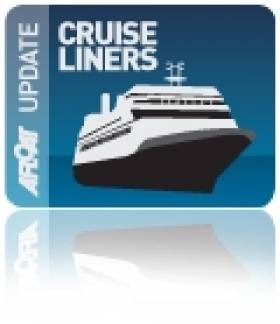Displaying items by tag: Viking Line
Former 'Lipstick' Ferry Calls to Saltees Islands
#SALTEES CRUISE CALL – The Saltee Islands off Co. Wexford was where the small cruiseship Expedition (1972/ 6,334grt) made an anchorage call yesterday, writes Jehan Ashmore.
The 140 passenger vessel which underwent a $13 million refit in 2009, specialises in cruising to some of the world's most remote regions. As usual for this type of cruiseship, a fleet of Zodiacs are provided for expedition excursions. Large common areas and observation decks provide panoramic views. As for all her cabins they too feature ocean-view windows or portholes and private en-suite facilities.
Expedition was a former Baltic Sea ferry which was sold in 2008 to G.A.P. Shipping Co. Ltd for their G-Adventures cruises having served as Ålandsfärjan for Viking Line's Mariehamn- Kapellskar on the Åland Islands route. The archipelago situated at the mouth of the Gulf of Bothnia form an autonomous Swedish-speaking region of Finland.
Prior to her Baltic Sea career she served P&O's subsidiary Normandy Ferries on the Dover-Boulogne route as their N.F Tiger which followed her original back-round as the Kattegat built for a Danish operator four decades ago.
The cruiseship retains her distinctive bright red hull colour inherited from her Viking Line years. Intriguingly when the company had to choose what colour to use for their first ferry Apollo, the answer found was rather novel as one of the owner's relatives produced her lipstick!
Brittany Ferries Re-Open Bilbao Route
The Cap Finistere has a 790 passenger / 500 vehicle capacity and the vessel will operate two round trips weekly with each crossing taking 24 hours. Interestingly an additional en-route call to Roscoff is scheduled on Sunday sailings bound for Bilbao which will take 33-hours. This is to facilitate a crew change, as the Cap Finistere does not operate on any of the company routes from France.
In 2009 the P&O service carried 180,000 passengers and 193,000 in 2008 but closed due to "unsustainable losses". There were 800 redundancies but some 150 staff jobs were secured through transfer. Click here for a previous posting. The company were in direct competition with Brittany Ferries existing two routes between Plymouth and Poole to Santander.
The Bilbao route brings the Brittany Ferries operations to five sailings weekly between the UK to Spain, two from Portsmouth to Santander and a single round-trip to Plymouth.
The Pride of Bilbao was sold late last year by ICG to the Baltic Sea based St. Peter Line at a profit of €9.4m. The vessel underwent refurbishment and was renamed Princess Anastasia and next month starts a new St. Petersburg-Stockholm service, with Russian bound sailings calling en route to
the Estonian capital of Tallinn. Click here for more details.
Pride of Bilbao's return to the Baltic is nearly full-circle as the 2,553 passenger / 600 vehicles vessel, built in 1986 as Olympia for Viking Line's also operated out of Stockholm to Helsinki, and at the time was one of the largest overnight passenger capacity ferries in the world.
Bilbao Returns to Baltic Sea 'Roots'
For the last 17 years the Pride of Bilbao has operated between Portsmouth and Bilbao under charter to P&O. Built in 1986, she was launched as Olympia for Viking Line between Stockholm and Helsinki, then the Baltic Sea ferry was one of the largest overnight passenger capacity ferries in the world. At 177 metres long the vessel can accommodate 2552-passengers, 600-vehicles and space for 77-trucks. She has a sister, the Mariella, which currently operates on Viking Line's Stockholm-Mariehamn–Helsinki service.
In 1993 the vessel was renamed Pride of Bilbao and launched a new service on the Bay of Biscay, under charter from her Scandinavian owners. The following year ICG purchased the Pride of Bilbao from Viking Line and she was re-registered to the Bahamas. The vessel was subsequently entered into a British bare-boat charter arrangement between P&O Ferries and ICG. Due to unsustainable losses the route closed on 28 September this year but rivals Brittany Ferries soon shortly announced they would reopen the route in Spring 2011.
Throughout the Pride of Bilbao's career under ICG (parent company of Irish Ferries), the cruiseferry has only once visited Ireland. In between Spanish sailings, she was sub-chartered for a three-day Christmas mini-cruise from Portsmouth to Dublin in 2004, where the Pride of Bilbao berthed at the ferryport close to the ICG headquarters.































































